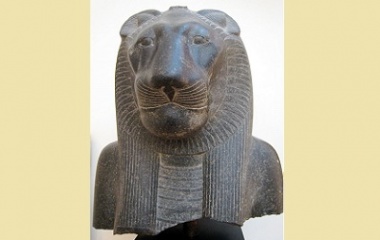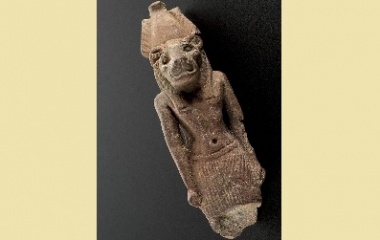- Pronunciation: sek-met
- Origin: Egypt
- Role: Warrior, hunter, healer
- Husband: Ptah
- Children: Nefertem, Imhotep
- Symbols: Sun disk, red linen, lioness
- Cult Center: Memphis
Who Is Sekhmet?
The lion-headed goddess of war, Sekhmet, is one of the oldest known Egyptian deities. She protected the great pharaohs and led them in war. From the breath of the goddess, the desert was born. Her very name is derived from the Egyptian word for power, and she was known for being fierce and bloodthirsty.
The dominant goddess of the twelfth dynasty was a solar deity as well, the daughter of the sun god Ra. Often, she is depicted dressed in red, to signify her blood lust, and wears a sun disk on her head encircled by a Ureaus cobra, which represents the story of her creation.
Sacrifices were offered to the goddess after the war in an effort to please her. Sekhmet was so widely worshipped that the Pharaoh Amenemhat I moved her cult center when the capital of Egypt moved to Itjtawy.
Origin
As the myth is told, the god of the sun, Ra, became angry with the people. They were not properly following the laws he had given them, and maintaining justice. As punishment for the disobedience, he pulled an aspect of his daughter from his eye in the form of a cobra that transformed to a lion. He then sent her to Earth to destroy the dissidents. The Eye of Ra became Sekhmet. She ravaged the people and the land was covered with blood.
Upon witnessing the carnage, Ra began feeling sorry and tried to call off the lioness, but she was bloodthirsty and ignored his plea. Anxious to stop the killing, Ra poured thousands of jugs of beer stained with pomegranate juice into the Nile, coloring it as red as blood. Sekhmet, thinking it was blood, drank it so quickly she became completely intoxicated and slept for days.
When Sekhmet woke up, her blood lust had diminished and humanity was saved from her wrath. Justice and balance existed once again.
Also, as it happened, the first thing Sekhmet saw when she opened her eyes from her drunken sleep, was the creator god, Ptah. She fell madly in love with him. Together, they had a son named Nefertum. The family of three became the Triad of Memphis.
Family of Sekhmet
Ptah
The handsome and brilliant Ptah was the creator of the physical universe. An artisan, the demiurge and crafter of all things, he was known to be quite willful.
Ptah is most often depicted wrapped up in cloth like a mummy, but his hands are left free to hold a staff. He had a shaved head and wore a skull cap. In addition to all the creating he had to do, Ptah was High Priest of his temple at Memphis, and held the esteemed title Great Leader of Craftsmen.
Nefertum
The son of the lioness and the creator, Nefertum, was born from a blue lotus bud that was floating in the water. He represents the sunrise, and it is said he created mankind from his tears.
Imhotep
Their adopted son Imhotep was the first known architect, engineer and physician in history. A sage and chief minister of the court of Pharaoh Djoser, Imhotep officiated over the building of the Step Pyramid of Djoser. Also known as a major figure in Ancient Egyptian medicine, he was given the status of a deity thousands of years after his death, despite being born a human.
Historical Influence
In the legends, Sekhmet was known as the Powerful One, a protector of the Pharaohs, with a bravery and style similar to the Uraeus cobra from which she originally derived. Armed with her qualities of aggression and bravery, she was a fierce warrior, also known for divine retribution, destruction and conquest. Overall, she was a terrifying goddess who symbolized absolute power and authority.
As the warrior manifestation of the sun, her flaming arrows overcame the enemies of Egypt. She was the bearer of plagues upon the enemies. With incantations and magical spells, Sekhmet could also cure the ill. Her priests were the doctors and magicians of the royal families of Egypt.
To honor the goddess, an annual festival of intoxication was held. The Egyptians drank beer to mimic the drunkenness of the goddess that had once stopped her wrath and saved mankind from destruction. There is historical evidence that tens of thousands of people attended the festivals.
To please the goddess Sekhmet and calm her wrath, rituals were performed before a different statue of the goddess each day of the year. This resulted in many statues of the goddess throughout Egypt. It is estimated that at one time there were 700 statues of her in the temple of Amenhotep III, one of the largest constructed in the era (covering approximately 86 acres). Amenhotep III was the ninth Pharaoh of the eighteenth dynasty which ruled Egypt in thirteenth century BC. It was a time of prosperity and international power for Egypt.
In 2016, eight statues of the goddess were discovered during an excavation project at the temple, which was built over 3000 years ago. Six of the statues depict her sitting on a throne and holding the symbol of life. Two of the statues represent Sekhmet standing, holding a scepter in her left hand and a symbol of life in her right hand. Three were discovered almost complete, while the remaining statues have been damaged, and only portions remain.
Not surprisingly, Sekhmet is depicted on all the statues wearing a tripartite wig and long body skimming dress as both were the fashion in ancient Egypt.










